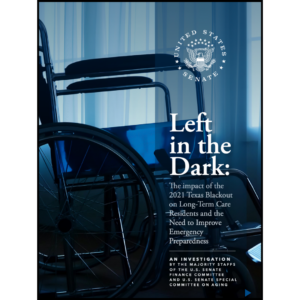Surface sanitation
According to the Centers for Disease Control and Prevention (CDC), approximately 15% of nursing home residents have infections, including wound infections, respiratory infections, urinary tract infections, or pneumonia. Another sobering statistic: Acute infections account for 27% of transfers of nursing home residents to hospitals, according to the Agency for Healthcare Research and Quality.
There are many types of infections in long-term care (LTC) facilities, but one type of infection has received increased attention over the past year or so: methicillin-resistant Staphylococcus aureus (MRSA). For example, one recent study showed that S. aureus, the second most common cause of bacteremia, soft tissue infections, and pneumonia in elderly patients in acute care settings, can be traced to LTC facilities, which, the study authors called, a “major reservoir” of MRSA. In these types of cases, even if there is a low incidence of MRSA infection in an LTC facility, its residents may be colonized with MRSA and act as carriers.
Prevalence increasing
MRSA, like C. difficile (which has doubled in nursing homes and other LTC facilities in the past several years and is now the most common cause of nosocomial infectious diarrhea in nursing homes), Vancomycin-resistant enterococci (VRE), and Norovirus are examples of infections that have become more prevalent outside of acute care settings, including places such as schools, exercise facilities, and LTC facilities. In LTC facilities, MRSA is often associated with urinary catheters and gastrostomy tube sites. Close living proximity, multiple medications, and pressure sores also make nursing homes ideal for breeding and spreading MRSA. In general, elderly, critically ill patients and those who have endured a prolonged hospital stay are particularly susceptible to MRSA infections, especially since MRSA infections tend to increase with advancing age.
While MRSA is typically spread by skin-to-skin contact, germs such as MRSA also have been found on environmental surfaces such as computer keyboards and sinks, suggesting that sources of environmental contamination are not limited to a patient’s belongings or patient rooms. Staph/MRSA can survive for weeks to several months on almost all surfaces. C. difficile bacteria can live for years on environmental surfaces. VRE bacteria are very hardy and can live for several days on surfaces. And noroviruses can survive on virtually any hard surface for up to 12 hours.
Several strategies may be employed to help reduce the spread of MRSA and other germs, including frequent and proper handwashing, along with proper environmental cleaning. LTC facilities may want to pay particular attention to their cleaning regimen, because research has shown that something as simple as the choice of wiping materials can dramatically affect the amount of disinfecting agent that actually reaches the surface being cleaned.
Cleaning to reduce infection rates
The CDC notes that cleaning and disinfecting environmental surfaces in healthcare facilities is critical to reducing the contribution of those surfaces to the incidence of healthcare-associated infections. In addition to proper hand hygiene, cleaning and disinfecting can help to minimize the transfer of microorganisms that can occur via hand contact between contaminated surfaces and LTC facility residents.
Surface sanitation may be a particularly effective method for stopping the spread of germs because, unlike in acute care settings, it is not practical to isolate infected individuals in LTC facilities. Moreover, effective surface sanitation is a practice that can be applied at all points on the LTC spectrum—from retirement homes and assisted living facilities to skilled nursing homes.
The CDC, along with the Healthcare Infection Control Practices Advisory Committee (HICPAC), offers guidance on environmental surface cleaning and disinfecting in the Guidelines for Environmental Infection Control in Health Care Facilities. The guidelines note that continued compliance with environmental infection control measures (including environmental surface cleaning and disinfecting) will decrease the risk of healthcare-associated infections among LTC facility residents. The Guidelines can be downloaded at https://www.cdc.gov.
Environmental surfaces
The CDC Guidelines divide environmental surfaces into two parts: medical equipment surfaces, such as knobs or handles on machines, carts, and similar equipment; and housekeeping surfaces, such as floors, walls, and tabletops. Housekeeping surfaces can be further divided into those with minimal hand contact (referred to as “low-touch” surfaces) and those with frequent hand contact (“high-touch” surfaces).
The number and types of microorganisms present on environmental surfaces are influenced by:
Number of people in the environment
Amount of activity
Amount of moisture (microorganisms are present in great numbers in moist organic environments, but some can also persist under dry conditions)
Presence of material capable of supporting microbial growth
Rate at which organisms suspended in air are removed
Type of surface and orientation (i.e., horizontal or vertical)
Principles of cleaning and disinfecting
According to the CDC Guidelines, cleaning is the necessary first step of any disinfection process. Cleaning is a form of decontamination that renders the environmental surface safe to handle or use by removing organic matter, salts, and visible soils, all of which interfere with microbial inactivation. The physical action of scrubbing with detergents and surfactants and rinsing with water removes a large number of microorganisms from surfaces.
After cleaning, attention can be turned to disinfecting the environmental surface. According to the CDC Guidelines, the following factors influence the choice of disinfection procedure:
Nature of the items to be disinfected
Number of microorganisms present
Innate resistance of those microorganisms to the inactivating effects of the germicide
Amount of organic soil present
Type and concentration of germicide used
Duration and temperature of germicide contact
If using a proprietary product, other specific indications and directions for use
Optimizing disinfectant solution
Careful attention to each step within the disinfection procedure is key to creating the best opportunity for effective disinfection to be achieved and maintained. The first step is the selection of the proper chemical germicide. While a number of disinfectants such as alcohols, hypochlorites, chlorohexidine, iodophors, hydrogen peroxide, and phenolics are used in healthcare facilities, many LTC facilities choose quaternary ammonium compounds (quats) to destroy, inhibit, or prevent growth of microbes on surfaces in patient/resident rooms.
Another important step is the mixing and application of the disinfectant. To be effective, it should be mixed according to directions and applied to the surface uniformly. The surface should remain wet for the amount of time recommended by the manufacturer. The wet application time is an often overlooked requirement in disinfection protocols.
The operative assumption underlying the principles of surface disinfection is that the active ingredients capable of rendering microbes nonfunctional are being delivered to the surface at the correct concentration. Previously underestimated factors, such as the type of cloth or wiper used to apply the disinfectant to the surface, may dramatically affect the concentration of quaternary amines delivered to the surface.
One source of contamination is the cleaning cloth, especially if left soaking in the dirty cleaning solution. In addition, when wipes are redipped, bucket solutions become contaminated almost immediately during cleaning. Continued use of the solution transfers an increasing number of microorganisms to each subsequent surface to be cleaned.
Effects of wiping materials
A study was conducted to examine the effects of commonly used wiping materials on the amount of active quaternary amines being released to surfaces for the purpose of disinfection. Three types of wiping materials/systems were studied:
Common cotton rags used with an open-bucket cleaning system
Disposable cellulose-based wipers used with an open-bucket cleaning system
Disposable nonwoven wipers (designed to be compatible with quaternary amines) used in a closed-bucket system
The cotton rags and cellulose-based wipers were tested following a common hospital use protocol in which the wipers are dipped into the open bucket to absorb disinfectant solution to be applied to a surface. The disposable nonwoven wipers were used in a closed-bucket system with 90 presaturated wipers extracted as needed for the purpose of surface application. This system keeps the wipers fresh in the container, presaturated with the preferred quaternary amine solution, for the period of use.
The study results showed a significant decline in the concentration of basic quaternary amines released when cotton rags or cellulose-based wipers were used in the open bucket system compared with the disposable nonwoven wipers in the closed-bucket system. Two chemical disinfectants were tested (see figures 1 and 2).
Chemical Disinfectant A
Chemical Disinfectant B
Quaternary amine release for the first cotton rag from the open bucket was 53% lower than original for disinfectant solution A and nearly 30% lower for disinfectant solution B.
Over eight hours, representative of a standard work shift, the quaternary amines release from cotton continued to decline rapidly. The quaternary amines released from the last cotton rag passed through the bucket were less than 1% of the original disinfectant concentration for disinfectant solution A.
The cellulose-based wipers also displayed a sharp reduction in active quaternary amines released for disinfectant solution A. At the conclusion of an eight-hour shift, the average quaternary amines released from the cellulose-based wipers were 21.5% of the original concentration.
In contrast, initial quaternary amines released for the disposable nonwoven wipers were only 16% lower than original for disinfectant solution A, and less than 1% lower for disinfectant solution B.
In extended three-day testing, the disposable nonwoven wipers retained an average of 88% of the original concentration of disinfectant solution A and an average of 94% of the original disinfectant B concentration.
Continuing challenge
The practice of infection control in LTC facilities continues to be a challenging one. Typically, LTC facilities have fewer resources, staff, and training opportunities than their counterparts in acute care facilities. However, LTC facilities can take cues from acute care facilities that are casting a critical eye toward traditional surface sanitation practices and tools.
As evidenced by the studies mentioned, commonly used materials such as cotton or cellulose-based wipers, are far from optimal in their ability to provide disinfectant actives to surfaces in the intended concentrations. The use of treated nonwoven wipers with a fiber preparation designed to be compatible with disinfectant chemicals improves the delivery of the disinfectant chemical to the surface. Wiping systems that sustain disinfectant concentrations over prolonged periods can improve access and disinfection protocol consistency. Ultimately, the use of these tools help optimize a disinfection practice when LTC facilities are faced with MRSA and other infectious diseases, helping LTC facilities to improve the application of basic standard precautions.
To send your comments to the author and editors, e-mail kosobud0908@iadvanceseniorcare.com.
Related Articles
Topics: Articles , Facility management , Operations











